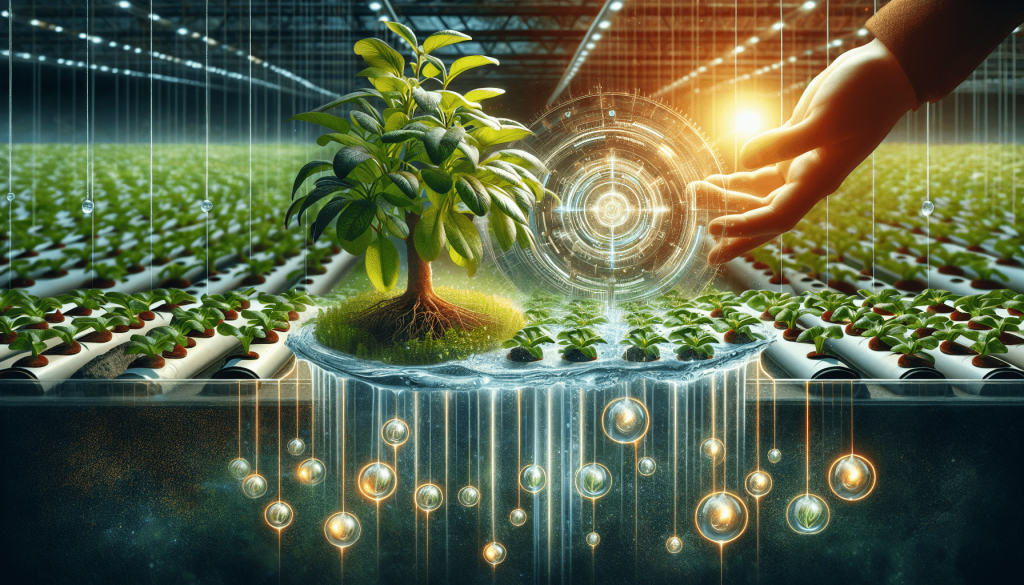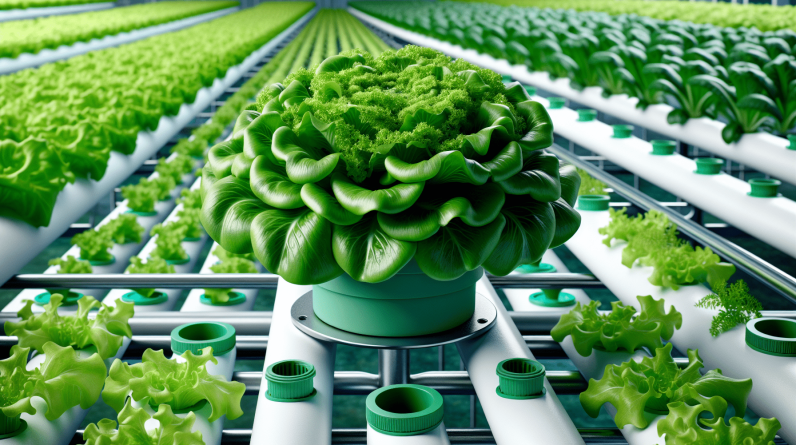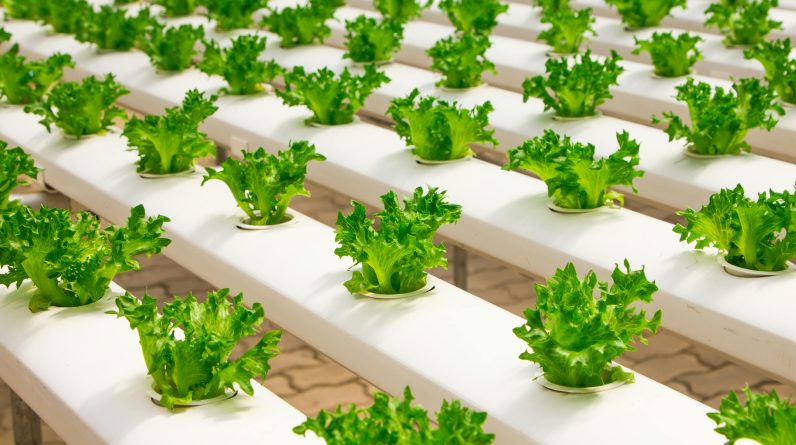
Imagine a world where traditional farming is revolutionized by a futuristic method that requires no soil, minimal water, and less space. This is the potential future of agriculture with hydroponic farming. By harnessing the power of water-based nutrient solutions, this innovative technique is reshaping the way we grow crops. Gone are the days of relying solely on traditional farming methods; hydroponic farming offers a beacon of hope for sustainable and efficient food production. With its ability to be implemented anywhere, from urban rooftops to desert landscapes, this article explores the exciting possibilities of hydroponic farming and how it could revolutionize the way we feed the world.

Benefits of Hydroponic Farming
Water conservation
Hydroponic farming offers significant water conservation benefits compared to traditional soil-based agriculture. With hydroponics, plants are grown in a nutrient-rich water solution that is recirculated through the system, eliminating the need for excessive water usage. This not only reduces water waste but also minimizes the strain on local water sources, making hydroponics a sustainable farming method.
No soil needed
One of the key advantages of hydroponic farming is that it eliminates the dependence on soil for plant growth. Instead, plants are provided with essential nutrients directly through the water solution. This allows for the cultivation of crops in areas where the soil is unsuitable for traditional farming, such as in urban environments or areas with poor soil quality. By removing the need for soil, hydroponics opens up new possibilities for agriculture and provides flexibility in choosing farming locations.
Controlled environment
Hydroponic systems allow for precise control over the growing conditions, creating an optimal environment for plants. Variables such as temperature, humidity, and light can be carefully adjusted to meet the specific needs of each crop. This level of control reduces the risk of crop failure due to external factors and enables farmers to grow crops consistently throughout the year. Furthermore, by controlling the environment, hydroponic farming minimizes the use of pesticides and herbicides, leading to healthier produce.
Higher yield
In hydroponic farming, plants have constant access to water, nutrients, and oxygen, resulting in accelerated growth and higher yields. The controlled environment and optimal nutrient delivery enable plants to focus their energy on growth instead of searching for resources in the soil. Additionally, hydroponic systems maximize space utilization by growing crops vertically, allowing for higher plant density and increased productivity per square foot.
Year-round production
Unlike traditional farming methods that are highly dependent on seasons and weather conditions, hydroponic farming enables year-round production. By providing a controlled environment and optimal growing conditions, crops can be cultivated regardless of external factors such as temperature or natural light availability. This not only ensures a consistent supply of fresh produce throughout the year but also reduces the vulnerability of crops to seasonal fluctuations and climate change.
History of Hydroponic Farming
Ancient practices
Although hydroponic farming is often seen as a modern innovation, its roots can be traced back to ancient civilizations. The Hanging Gardens of Babylon, one of the Seven Wonders of the Ancient World, are believed to have employed hydroponic systems to cultivate plants in a desert region. In ancient Egypt, the Nile River played a crucial role as a source of both water and nutrients for floating gardens, which utilized hydroponic principles. These early practices demonstrate the ingenuity of ancient cultures in harnessing the power of hydroponics to overcome agricultural challenges.
Modern developments
The modern era saw significant advancements in hydroponic farming techniques. In the 17th century, botanists and scientists experimented with nutrient solutions, paving the way for the development of hydroponic systems as we know them today. Commercial hydroponics gained traction in the mid-20th century, with the Netherlands leading the way in innovative greenhouse farming techniques. These developments not only improved crop yields but also paved the way for the widespread adoption of hydroponics across the world.
NASA’s contribution
An unexpected player in the advancement of hydroponic farming was NASA. In the 1990s, NASA researchers began exploring the potential of hydroponics for space missions. This research aimed to provide astronauts with fresh food during their extended stays in space. The development of efficient hydroponic systems capable of sustaining plant growth in microgravity environments not only contributed to space exploration efforts but also brought new insights and technologies to terrestrial hydroponic farming.
Basic Principles of Hydroponic Farming
Nutrient solution
In hydroponic farming, plants receive their nutrients from a carefully formulated solution. This nutrient solution contains all the essential minerals and elements required for plant growth and is delivered directly to the plant roots. By precisely controlling the nutrient composition, farmers can tailor the solution to meet the specific needs of each crop, ensuring optimal growth and yield.
Growing media
While hydroponic farming eliminates the need for soil, plants still require a support system to anchor their roots and provide stability. Various growing media can be used in hydroponics, such as perlite, coconut coir, or even the use of inert materials like rockwool or clay pellets. These growing media provide a stable substrate for the plants’ roots and allow for efficient water and nutrient distribution.
Water management
Water is a critical component of hydroponic farming, and proper water management is essential for the success of the system. Hydroponic systems are designed to recirculate water, minimizing water usage and conserving this valuable resource. Implementation of proper filtration, monitoring, and control systems helps maintain the quality of the water and ensures the longevity of the hydroponic setup.
pH and EC control
Maintaining the correct pH level and electrical conductivity (EC) of the nutrient solution is crucial in hydroponic farming. The pH level affects nutrient availability to the plants, while EC indicates the concentration of dissolved minerals in the solution. Regular monitoring and adjustment of pH and EC ensure the optimal absorption of nutrients by the plants, promoting healthy growth and preventing nutrient deficiencies or toxicities.
Air circulation
In addition to water and nutrient management, providing adequate air circulation is vital in hydroponic systems. Plants require oxygen for root respiration, and stagnant air can lead to root suffocation and potential crop failure. Proper ventilation and air circulation systems ensure a constant supply of fresh air, enhancing plant health and overall system performance.
Types of Hydroponic Systems
Nutrient Film Technique (NFT)
NFT is a popular hydroponic system that involves a thin film of nutrient solution flowing over the roots of the plants. The roots are exposed to the air, ensuring optimal oxygenation, while the continuous flow of solution provides a constant supply of nutrients. This system is ideal for growing leafy green vegetables and herbs.
Deep Water Culture (DWC)
DWC is a simple yet effective hydroponic system where plants’ roots are suspended in a nutrient-rich water solution. The roots are constantly submerged, ensuring continuous nutrient uptake and oxygenation. DWC is commonly used for growing larger plants such as tomatoes and cucumbers.
Drip irrigation
Drip irrigation is a widely used hydroponic system that delivers nutrient solution directly to the plants’ roots through small tubes or emitters. This system allows for precise control over nutrient delivery and minimizes water usage. Drip irrigation is suitable for a variety of crops, including fruits, vegetables, and herbs.
Ebb and Flow
In the ebb and flow system, also known as flood and drain, plants are periodically flooded with the nutrient solution, which then drains back into a reservoir. This cyclic flooding and draining ensure proper oxygenation of the roots and nutrient uptake. This system is versatile and can be used to grow a wide range of crops.
Aeroponics
Aeroponics is an advanced hydroponic system that suspends the plants’ roots in a mist or fine droplets of nutrient solution. This highly efficient method allows for maximum oxygenation and nutrient absorption. Aeroponics is often utilized for growing delicate or high-value crops such as strawberries.

Successful Crops in Hydroponic Farming
Leafy greens
Hydroponic farming is particularly well-suited for growing leafy greens such as lettuce, spinach, and kale. These crops have relatively short growing cycles and can be successfully cultivated in hydroponic systems. The controlled environment and optimized nutrient delivery allow for rapid and consistent growth, resulting in high-quality, nutritious leafy greens.
Herbs
Herbs like basil, mint, and parsley thrive in hydroponic systems. By providing the ideal growing conditions and constant access to nutrients, hydroponic farming ensures aromatic and flavorful herbs year-round. Additionally, hydroponic herbs are less prone to pests and diseases, reducing the need for chemical interventions.
Tomatoes
Hydroponic farming has revolutionized tomato production by providing an environment that maximizes yield and quality. With controlled temperature, optimal nutrient delivery, and vertical cultivation, hydroponic systems allow for continuous tomato production and prevent diseases commonly associated with soil cultivation.
Cucumbers
Cucumber plants flourish in hydroponic systems, producing high yields of crisp and flavorful fruits. The vertical growth and trellising techniques used in hydroponic cucumber cultivation utilize space efficiently, making it an ideal method for urban farming and limited land availability.
Strawberries
Hydroponic systems offer a perfect solution for growing strawberries, especially in regions with unsuitable soil or unpredictable weather conditions. By ensuring nutrient availability, water management, and controlled lighting, hydroponics provides the ideal environment for strawberries, resulting in flavorful and bountiful harvests.
Challenges in Hydroponic Farming
High initial investment
One of the prominent challenges associated with hydroponic farming is the initial investment required to set up the system. The need for specialized equipment, infrastructure, and technology increases the upfront costs compared to traditional farming methods. However, it’s essential to consider the long-term benefits and potential for higher yields and savings in resources like water and land.
Technical knowledge requirements
Hydroponic farming requires a certain level of technical knowledge and expertise. Farmers need to understand the principles of hydroponics, nutrient management, and system maintenance. Acquiring this expertise may involve additional training and learning, particularly for those transitioning from traditional farming practices. However, with increasing knowledge-sharing platforms and educational resources, it is becoming more accessible for aspiring hydroponic farmers.
Disease and pest management
While hydroponic systems decrease the risk of soil-borne diseases, they can still face challenges related to pests and pathogens. Since hydroponic environments are highly controlled, any introduction of pests or diseases can quickly spread and affect the entire crop. Implementing rigorous biosecurity measures, regular monitoring, and timely interventions are essential in maintaining a pest and disease-free hydroponic operation.
Root oxygenation
One critical aspect of hydroponic farming is ensuring proper oxygenation of the plant roots. Insufficient oxygenation can lead to root rot and other detrimental conditions. Implementing proper aeration systems, monitoring dissolved oxygen levels, and maintaining the right water oxygenation techniques are crucial for healthy root development.
Effective monitoring
Hydroponic farming relies heavily on monitoring various parameters such as pH levels, electrical conductivity, nutrient concentrations, and environmental factors. Keeping track of these variables requires consistent monitoring and data analysis to maintain optimal conditions for plant growth. Regular adjustments and fine-tuning of the system based on monitoring results ensure the best possible growth and yield.
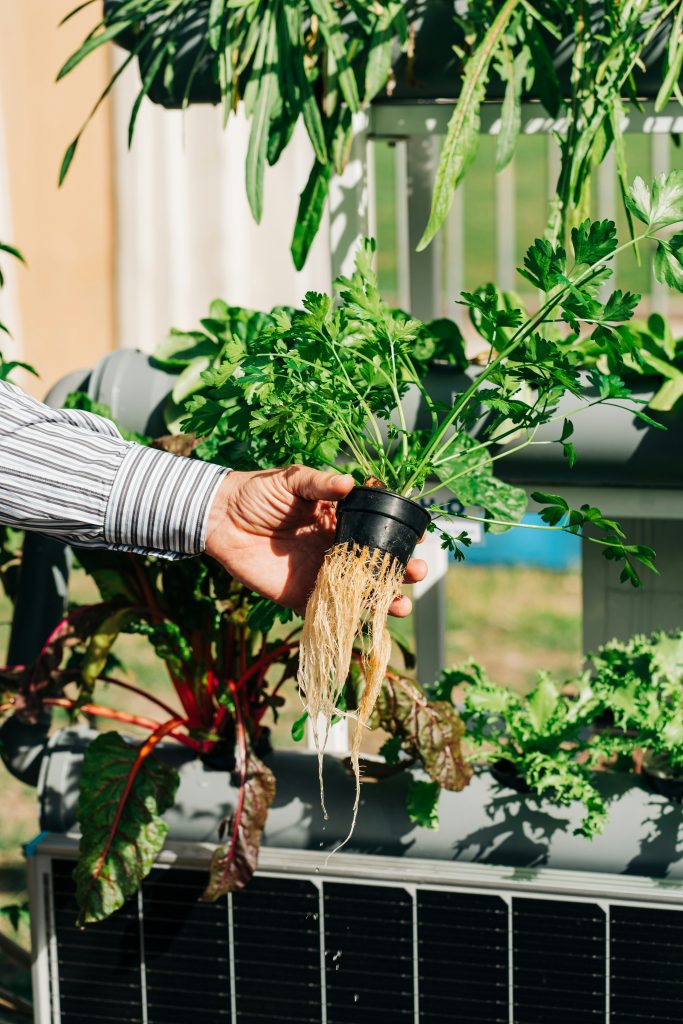
Advancements in Hydroponic Farming
Automation and robotics
Advancements in automation and robotics have transformed the way hydroponic farms are managed. Automated systems can regulate environmental factors, control nutrient delivery, and monitor crop health, reducing the need for manual labor and enhancing efficiency. Robotics has also been utilized for tasks like seeding, harvesting, and plant maintenance, allowing for increased precision and productivity.
Artificial intelligence
Artificial intelligence (AI) plays a significant role in optimizing hydroponic farming operations. AI algorithms can analyze vast amounts of data collected from sensors and monitoring systems, providing real-time insights on plant health, nutrient requirements, and system performance. This data-driven approach enables farmers to make informed decisions and optimize resource utilization for better yields and sustainability.
LED lighting
The development of energy-efficient LED lighting has revolutionized indoor hydroponic farming. LED lights can provide specific wavelengths and light spectrums tailored to the needs of different crops, enhancing photosynthesis and growth. Additionally, LED lights consume less energy, generate less heat, and have a longer lifespan, making them an ideal choice for hydroponic systems.
Vertical farming
Vertical farming has gained traction in hydroponic agriculture, especially in urban areas with limited space. Vertical systems utilize vertical stacking of plants, allowing for increased plant density and improved space utilization. By utilizing height instead of surface area, vertical farms can maximize the productivity of limited land, leading to higher yields and reduced environmental footprint.
Biocontrol methods
Hydroponic farming promotes the use of biocontrol methods to manage pests and diseases. Beneficial insects, microbes, and integrated pest management techniques are employed to minimize the use of chemical pesticides. This approach not only reduces the environmental impact but also ensures the production of healthier and safer crops.
Economic and Environmental Impact
Reduced land usage
One significant economic and environmental benefit of hydroponic farming is the reduced land usage. Traditional agriculture requires vast expanses of arable land, often leading to deforestation and habitat destruction. Hydroponic systems, on the other hand, can be implemented vertically, requiring significantly less land while producing higher yields. By maximizing land efficiency, hydroponics provides a sustainable solution for food production and preserves natural ecosystems.
Less water pollution
Conventional agriculture often leads to water pollution through the runoff of chemical fertilizers and pesticides. In hydroponic systems, water is carefully managed and recycled, minimizing the risk of pollution. Nutrient-rich water solutions are contained within closed-loop systems, reducing the potential for contamination of natural water sources. This proactive approach to water usage contributes to the conservation and protection of freshwater ecosystems.
Lower carbon emissions
Hydroponic farming has the potential to significantly reduce carbon emissions compared to traditional agriculture. By optimizing resource utilization, implementing energy-efficient technologies, and minimizing transportation distances, hydroponics minimizes the carbon footprint associated with food production. Locally grown hydroponic produce requires fewer transportation miles, leading to reduced emissions and a more sustainable food system.
Increased food security
Hydroponic farming offers excellent potential for increasing food security, particularly in regions with limited arable land or challenging climates. By providing a controlled environment and year-round production, hydroponics ensures a consistent supply of fresh produce. This can help mitigate the risks associated with external factors such as extreme weather events, pests, or crop diseases, enhancing food availability and resilience.
Job creation
Hydroponic farming presents opportunities for job creation in both rural and urban areas. The implementation and maintenance of hydroponic systems require skilled labor, from system design and construction to monitoring and crop management. Additionally, the localized nature of hydroponic farms promotes community engagement and involvement, contributing to the socio-economic development of regions.
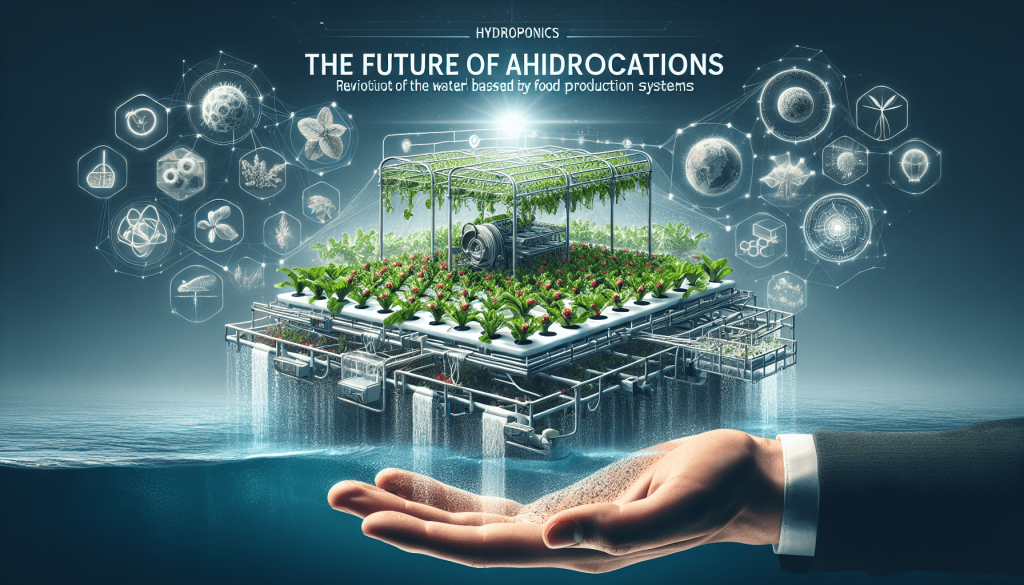
Integration of Hydroponic Farming with Other Technologies
Internet of Things (IoT)
The integration of hydroponic farming with the Internet of Things (IoT) enables real-time monitoring and control of various aspects of the system. IoT sensors and devices can collect data on temperature, humidity, nutrient levels, and other factors, allowing farmers to remotely manage and optimize their hydroponic operations. This integration enhances efficiency, reduces resource wastage, and enables data-driven decision-making.
Blockchain technology
Blockchain technology can be utilized to optimize transparency and traceability in the hydroponic supply chain. By recording every step of production, distribution, and sales on an immutable ledger, consumers can have confidence in the authenticity and quality of hydroponically grown products. Additionally, blockchain can streamline transactions, simplify compliance processes, and facilitate fair trade practices within the industry.
Renewable energy sources
Hydroponic farms can leverage renewable energy sources to power their operations, further minimizing their carbon footprint. Solar panels, wind turbines, or even biogas systems can be integrated into hydroponic farms, reducing reliance on conventional energy sources. This integration not only reduces operational costs but also improves the sustainability and environmental impact of hydroponic farming.
Biotechnology advancements
Advancements in biotechnology offer new possibilities for enhancing the efficiency and productivity of hydroponic systems. Genetic engineering techniques can be used to modify crops for better nutrient uptake, disease resistance, or environmental adaptability. Biotechnology also enables the development of improved nutrient solutions, biostimulants, and biofertilizers tailored for hydroponic farming, further optimizing plant growth and yields.
Data analytics
Data analytics plays a crucial role in optimizing hydroponic farming practices. By collecting and analyzing data on environmental conditions, nutrient levels, and plant health, farmers can identify trends and patterns to improve resource allocation and crop management. Through data-driven insights, farmers can fine-tune their operations, maximize yields, and minimize resource waste, leading to more sustainable and profitable hydroponic systems.
Future Trends and Possibilities
Indoor farming revolution
The future of hydroponic farming lies in the indoor farming revolution. By utilizing vertical growth systems, artificial lighting, and advanced automation, indoor hydroponic farms can be established anywhere, including urban areas with limited space. This revolution has the potential to transform the way we grow and consume food, ensuring a consistent supply of fresh produce all year round.
Integration with urban planning
Hydroponic farming can play a vital role in integrating food production into urban planning. By repurposing unused or underutilized urban spaces, such as rooftops or abandoned buildings, hydroponic farms can contribute to local food production and food security. Integrating urban agriculture into city planning enables sustainable and resilient food systems, reduces transportation distances, and enhances community engagement.
Space exploration applications
The advancements in hydroponic farming developed for space missions have practical applications on Earth, and the reverse holds true as well. Hydroponic systems designed for space exploration can provide valuable insights and technologies for terrestrial agriculture. The unique challenges of growing food in space, such as limited resources and microgravity, drive innovation and push the boundaries of hydroponics, benefiting both space exploration and agriculture on Earth.
Customized nutrient formulations
Further advancements in hydroponic farming will focus on tailoring nutrient formulations to meet specific crop requirements. With an increased understanding of plant nutritional needs, farmers can develop customized nutrient solutions for optimal growth and yield. By fine-tuning nutrient compositions, hydroponic systems can maximize crop productivity, nutritional value, and taste, revolutionizing the future of farming.
Development of new crops
Hydroponic farming offers exciting possibilities for the development and cultivation of new crop varieties. By creating controlled environments and optimizing nutrient delivery, farmers can experiment with growing non-traditional or exotic crops. This opens up opportunities for diversifying agricultural production, exploring niche markets, and meeting the changing dietary preferences of consumers.
With its numerous benefits, hydroponic farming is a growing field that holds tremendous potential for the future of agriculture. From increased resource efficiency and sustainable production to the integration of cutting-edge technologies, hydroponic farming provides a pathway towards a more resilient, secure, and environmentally friendly food system. Embracing this innovative approach to farming can help address the challenges faced by traditional agriculture and pave the way for a brighter future in food production.
